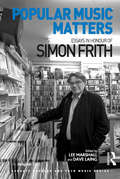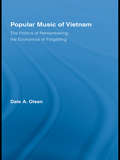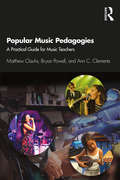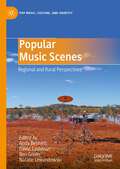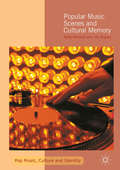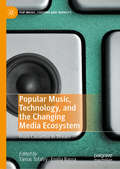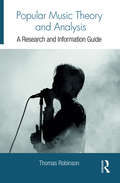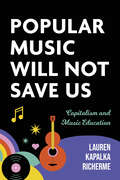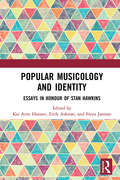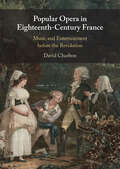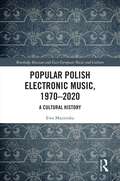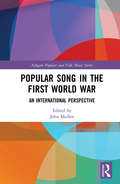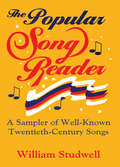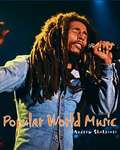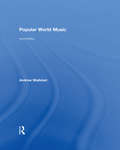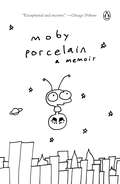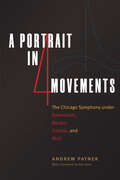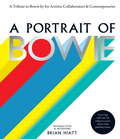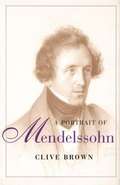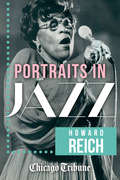- Table View
- List View
Popular Music Matters: Essays in Honour of Simon Frith (Ashgate Popular and Folk Music Series)
by Lee Marshall Dave LaingSimon Frith has been one of the most important figures in the emergence and subsequent development of popular music studies. From his earliest academic publication, The Sociology of Rock (1978), through to his recent work on the live music industry in the UK, in his desire to ’take popular music seriously’ he has probably been cited more than any other author in the field. Uniquely, he has combined this work with a lengthy career as a music critic for leading publications on both sides of the Atlantic. The contributions to this volume of essays and memoirs seek to honour Frith’s achievements, but they are not merely ’about Frith’. Rather, they are important interventions by leading scholars in the field, including Robert Christgau, Antoine Hennion, Peter J. Martin and Philip Tagg. The focus on ’sociology and industry’ and ’aesthetics and values’ reflect major themes in Frith’s own work, which can also be found within popular music studies more generally. As such the volume will become an essential resource for those working in popular music studies, as well as in musicology, sociology and cultural and media studies.
Popular Music of Vietnam: The Politics of Remembering, the Economics of Forgetting (Routledge Studies in Ethnomusicology)
by Dale A. OlsenBased on the author’s research in Ho Chi Minh City, Hanoi, and other urban areas in Vietnam, this study of contemporary Vietnamese popular music explores the ways globalization and free market economics have influenced the music and subcultures of Vietnamese youth, focusing on the conflict between the politics of remembering, nurtured by the Vietnamese Communist government, and the politics of forgetting driven by the capitalist interests of the music industry. Vietnamese youth at the end of the second and beginning of the third millennium are influenced by the challenges generated by a number of seemingly opposite ideologies and realities, such as "the past" versus "the present," socialism versus capitalism, and cultural traditionalism versus globalization. Vietnam has undergone a radical demographic shift with a very pronounced youth movement, and consequently, Vietnamese popular culture has been radically reshaped by a young population coming of age in the twenty-first century. As Olsen reveals, the way Vietnamese young people cope with these opposing and contrasting forces is often expressed in their active and passive music making.
Popular Music Pedagogies: A Practical Guide for Music Teachers
by Bryan Powell Matthew Clauhs Ann C ClementsPopular Music Pedagogies: A Practical Guide for Music Teachers provides readers with a solid foundation of playing and teaching a variety of instruments and technologies, and then examines how these elements work together in a comprehensive school music program. With individual chapters designed to stand independently, instructors can adapt this guide to a range of learning abilities and teaching situations by combining the pedagogies and methodologies presented. This textbook is an ideal resource for preservice music educators enrolled in popular music education, modern band, or secondary general methods coursework and K-12 music teachers who wish to create or expand popular music programs in their schools. The website includes play-alongs, video demonstrations, printed materials, and links to useful popular music pedagogy resources.
Popular Music Scenes: Regional and Rural Perspectives (Pop Music, Culture and Identity)
by Andy Bennett David Cashman Ben Green Natalie LewandowskiThis book examines regional and rural popular music scenes in Europe, Asia, North America and Australia. The book is divided into four parts. Part 1 will focus on the spatial aspects of regional popular music scenes and how place and locality inform the perceptions and discourses of those involved in such scenes. Part 2 focuses on the technologies and forms of distribution whereby regional and rural popular music scenes exist and, in many cases co-exist in forms of trans-local connection with other scenes. Part 3 considers the importance of collective memory in the way that regional and rural popular music scenes are constructed in both the past and the present. Part 4 examines themes of industry and policy, in relation to culture and music, as these impact on the nature and identity of rural and regional popular music scenes.
Popular Music Scenes and Cultural Memory
by Andy Bennett Ian RogersThis volume explores the ways in which music scenes are not merely physical spaces for the practice of collective musical life but are also inscribed with and enacted through the articulation of cultural memory and emotional geography. The book draws on empirical data collected in cites throughout Australia. In terms of understanding the relationship between music scenes and participants, much of the existing popular music literature tends to avoid one key aspect of scene: its predominant past-tense and memory-based nature. Nascent music scenes may be emergent and on-going but their articulation in the present is often based on past events, ideas and histories. There is a noticeable gap between the literature concerning popular music ethnography and the growing body of work on cultural memory and emotional geography. This book is a study of the conceptual formation and use of music scenes by participants. It is also an investigation of the structures underpinning music scenes more generally.
Popular Music, Technology, and the Changing Media Ecosystem: From Cassettes to Stream (Pop Music, Culture and Identity)
by Emília Barna Tamas TofalvyThis book explores the relationships between popular music, technology, and the changing media ecosystem. More precisely, it looks at infrastructures and practices of music making and consuming primarily in the post-Napster era of digitization – with some chapters looking back on the technological precursors to digital culture – marked by the emergence of digital tools and platforms such as YouTube or Spotify. The first section provides a critical overview of theories addressing popular music and digital technology, while the second section offers an analysis of the relationship between musical cultures, taste, constructions of authenticity, and technology. The third section offers case studies on the materialities of music consumption from outside the western core of popular music production. The final section reflects on music scenes and the uses and discourses of social media.
Popular Music Theory and Analysis: A Research and Information Guide (Routledge Music Bibliographies)
by Thomas RobinsonPopular Music Theory and Analysis: A Research and Information Guide uncovers the wealth of scholarly works dealing with the theory and analysis of popular music. This annotated bibliography is an exhaustive catalog of music-theoretical and musicological works that is searchable by subject, genre, and song title. It will support emerging scholarship and inquiry for future research on popular music.
Popular Music Will Not Save Us: Capitalism and Music Education (Counterpoints: Music and Education)
by Lauren K. RichermeIn today's globalized landscapes, both traditional and progressive K–12 music education practices, including those associated with popular music, can further capitalism-related inequities. In this context, music educators and students might consider how they position themselves and their music-making practices in relation to capitalist aims and processes and confront the more unethical aspects of capitalism.Popular Music Will Not Save Us challenges music educators to rethink their philosophical stances in the face of contemporary capitalist values and explores the intersection of music education and globalized capitalism, unveiling how certain practices exacerbate material inequities and erode social responsibility. As author Lauren Kapalka Richerme unravels the complexities of music education, her analysis sheds light on how prevalent practices can inadvertently uphold capitalist ideals and reinforce individualism, unceasing accumulation, and precarity in the workforce. Given that no musical genre inherently challenges problematic aspects of capitalism, Richerme proposes that music educators instead focus on affective flows, or the circulation of sensations within pedagogical spaces, and consider four alternative positionalities: thriving within, surviving under, resisting, and challenging capitalism.Popular Music Will Not Save Us advocates for a shift away from capitalistic individualism and inequities and toward a more equitable, affective pedagogical mode. Now is the time to transcend traditional boundaries and embrace a new paradigm that prioritizes social impact over commercial gain.
Popular Musicology and Identity: Essays in Honour of Stan Hawkins
by Kai Arne HansenPopular Musicology and Identity paves new paths for studying popular music’s entwinement with gender, sexuality, ethnicity, class, locality, and a range of other factors. The book consists of original essays in honour of Stan Hawkins, whose work has been a major influence on the musicological study of gender and identity since the early 1990s. In the new millennium, musicological approaches have proliferated and evolved alongside major shifts in the music industry and popular culture. Reflecting this plurality, the book reaches into a range of musical contexts, eras, and idioms to critically investigate the discursive structures that govern the processes through which music is mobilised as a focal point for negotiating and assessing identity. With contributions from leading scholars in the field, Popular Musicology and Identity accounts for the state of popular musicology at the onset of the 2020s while also offering a platform for the further advancement of the critical study of popular music and identity. This collection of essays thus provides an up-to-date resource for scholars across fields such as popular music studies, musicology, gender studies, and media studies.
Popular Opera in Eighteenth-Century France: Music and Entertainment before the Revolution
by David CharltonThis is the first book for a century to explore the development of French opera with spoken dialogue from its beginnings. Musical comedy in this form came in different styles and formed a distinct genre of opera, whose history has been obscured by neglect. Its songs were performed in private homes, where operas themselves were also given. The subject-matter was far wider in scope than is normally thought, with news stories and political themes finding their way onto the popular stage. In this book, David Charlton describes the comedic and musical nature of eighteenth-century popular French opera, considering topics such as Gherardi's theatre, Fair Theatre and the 'musico-dramatic art' created in the mid-eighteenth century. Performance practices, singers, audience experiences and theatre staging are included, as well as a pioneering account of the formation of a core of 'canonical' popular works.
Popular Polish Electronic Music, 1970–2020: A Cultural History (Routledge Russian and East European Music and Culture)
by Ewa MazierskaPopular Polish Electronic Music, 1970–2020 offers a cultural history of popular Polish electronic music, from its beginning in the late 1960s/early 1970s up to the present day, in the context of Polish economic, social and political history, and the history of popular music in this country. From the perspective of production, scene, industry and consumption, the volume considers the issue of access to electronic instruments in the 1970s and 1980s, and the variety of inspirations, such as progressive rock and folk music, that have contributed to the development of Polish electronic music as it is known today. The widespread contribution of Polish electronic music to film is also considered. This is a valuable resource for scholars and researchers of electronic music, popular music and (Eastern) European music and culture.
Popular Song in the First World War: An International Perspective (Ashgate Popular and Folk Music Series)
by John MullenWhat did popular song mean to people across the world during the First World War? For the first time, song repertoires and musical industries from countries on both sides in the Great War as well as from neutral countries are analysed in one exciting volume. Experts from around the world, and with very different approaches, bring to life the entertainment of a century ago, to show the role it played in the lives of our ancestors. The reader will meet the penniless lyricist, the theatre chain owner, the cross-dressing singer, fado composer, stage Scotsman or rhyming soldier, whether they come from Serbia, Britain, the USA, Germany, France, Portugal or elsewhere, in this fascinating exploration of showbiz before the generalization of the gramophone. Singing was a vector for patriotic support for the war, and sometimes for anti-war activism, but it was much more than that, and expressed and constructed debates, anxieties, social identities and changes in gender roles. This work, accompanied by many links to online recordings, will allow the reader to glimpse the complex role of popular song in people’s lives in a period of total war.
The Popular Song Reader: A Sampler of Well-Known Twentieth-Century Songs
by William E Studwell Frank Hoffmann Beulah B RamirezWho is the Bill Bailey whose exploits were chronicled in song? How many popular songs have titles containing the words “moon,” “heart,” or “baby”? Where is the road to Mandalay? How many female names can you think of that have been mentioned in song titles? Discover this fascinating information and more about some of America's most known and loved popular songs in this delightful sampler. The Popular Song Reader contains over 200 short essays on the backgrounds of a wide variety of twentieth-century American popular songs. The witty and knowledgeable essays touch upon several hundred traditional-style pop songs as well as early rock compositions. The essays are filled with anecdotes, humor, irony, and even poetry that reflect the author's offbeat and somewhat irreverent manner, while also presenting a broad spectrum of American popular songs in their historical and cultural contexts. In addition to information about each song and its composer, the author also discusses how the song reflected society at the time and also how the song itself has influenced popular culture. Pop music fans will find this a highly entertaining and readable guide to the best American popular music of the twentieth century. Divided into five sections, the book covers popular songs from the Tin Pan Alley era (By the Light of the Silvery Moon, California, Here I Come, Let Me Call You Sweetheart, She'll Be Comin’Round the Mountain, and When Irish Eyes are Smiling), the swing/big band era (Don't Get Around Much Anymore, Heart and Soul, In the Mood, Stardust, and Stormy Weather), and the rock era (Chances Are, Good Vibrations, Love Me Tender, Misty, Rock Around the Clock, Stop! In the Name of Love, and The Twist). The Popular Song Reader provides new insights on all-time favorites from Broadway musicals, movies, and television including Ain't Misbehavin', Give My Regards to Broadway, My Funny Valentine, Aquarius, Cabaret, Luck Be a Lady, Mack the Knife, Don't Fence Me In, Over the Rainbow, Singin’in the Rain, and the theme songs from Star Wars , All in the Family, Cheers, and M*A*S*H.
Popular Viennese Electronic Music, 1990–2015: A Cultural History
by Ewa MazierskaThe author presents a cultural history of popular Viennese electronic music from 1990 to 2015, from the perspectives of production, scene and national and international reception. To illustrate this history in depth, a number of case studies of the most successful and distinguished musicians are explored, such as Kruder and Dorfmeister, Patrick Pulsinger, Tosca, Electric Indigo and Sofa Surfers. The author draws on research about electronic music, the relationship between music and the urban environment, the history of Austria and Vienna, music scenes and fandom, the digital shift , stardom in popular music (especially electronic music), as well as theories of postmodernism. Chapters 4 and 8 of this book are freely available as downloadable Open Access PDFs at http://www.taylorfrancis.com under a Creative Commons Attribution-Non Commercial-No Derivatives (CC-BY-NC-ND) 4.0 license.
Popular World Music
by Andrew ShahriariExploring Popular World Music is the first introductory level text written to introduce students to popular music styles from around the world. Focusing on styles that all students will know -- from Reggae to Klezmer, from Afro-Pop to Kodo drums--the book offers a comprehensive, listening-oriented introduction to the world's popular musical cultures. Each chapter will focus on a specific music style and its associated geographic locale. The salient musical and cultural features associated with each example are discussed in detail to increase our appreciation of the music. Relevant artists will be highlighted and suggestions for further reading and listening will be offered. By the end of the book, the student should be able to 1) recognize a variety of world music styles, 2) articulate musical and cultural knowledge associated with each style, and 3) identify important artists related to the genre. Supplementing the text will be a web site fcreated by the author) featuring the author's world music map, enabling students to explore pop music cultures as they relate to each other; as well as an iTunes playlist for all the highlighted selections in the book. This book should strongly appeal to Intro to World Music Courses for non-majors who wish to study popular rather than traditional musics of the world, which would encompass a large majority of students enrolled in these courses.
Popular World Music
by Andrew ShahriariPopular World Music, Second Edition introduces students to popular music genres and artists from around the world. Andrew Shahriari discusses international music styles familiar to most students—Reggae, Salsa, K-Pop, and more—with a comprehensive listening-oriented introduction to mainstream musical culture. Each chapter focuses on specific music styles and their associated geographic origin, as well as best-known representative artists, such as Bob Marley, Carmen Miranda, ABBA, and Ladysmith Black Mambazo. The text assumes no prior musical knowledge and emphasizes listening as a pathway to learning about music and culture. The subject matter fulfills core, general education requirements found today in the university curriculum. The salient musical and cultural features associated with each example are discussed in detail to increase appreciation of the music, its history, and meaning to its primary audience. NEW to this edition Updates to content to reflect recent developments in resources and popular music trends. Contributing authors in additional areas, including Folk Metal, Chinese Ethnic Minority Rock, and Trinidadian Steel Drum and Soca. "Artist Spotlight" sections highlighting important artists, such as Mary J. Blige, Bob Marley, Tito Puente, Enya, Umm Kulthum and more. "Ad-lib Afterthought" sections and "Questions to Consider" to prompt further discussion of each chapter. Lots of new photos! Updated and additional website materials for students and instructors.
Popularität – Lied und Lyrik vom 16. bis zum 19. Jahrhundert (Studien zu Musik und Gender)
by Hannah Berner Frédérique Renno Sarah RuppeWas bedeutet Popularität in Bezug auf Lied und Lyrik? Welche Rolle spielen dafür deren Produktion, Medialität und Rezeption? Der vorliegende Band legt den Schwerpunkt auf Musik, Poesie und ihr Zusammenspiel in dem epochenübergreifenden Zeitraum vom 16. bis zum 19. Jahrhundert. Illustriert werden die entsprechenden produktionsästhetischen Voraussetzungen, medialen Aspekte und rezeptionsgeschichtlichen Zusammenhänge, um der Frage nachzugehen, welche Komponenten ein Lied oder ein Gedicht haben muss, damit es als populär charakterisiert werden kann. Zwölf Beiträge untersuchen und definieren das Phänomen Popularität aus literatur-, sprach-, musikwissenschaftlicher und theologischer Perspektive und dienen als Diskussionsgrundlage für eine kulturwissenschaftliche Erforschung von Popularität.
Populärkultur und sozialökologische Transformation: Potenziale einer reflexiven Nachhaltigkeitskultur auf Musikfestivals (Musik und Gesellschaft)
by Ina KahleMusikfestivals gelten in der Regel nicht als Orte gelebter ökologischer Nachhaltigkeit. Ein anscheinend unbedachter Umgang mit benötigten Ressourcen sowie der oftmals unverhältnismäßige Konsum von Alkohol sprechen zunächst nicht dafür, dass gerade hier eine Chance für einen im nachhaltigen Sinne erforderlichen Wertewandel der Gesellschaft liegt.Dieses Buch widmet sich einem in diesem Kontext bisher weitgehend unbeachteten Aspekt von Musikfestivals: In einer umfangreichen empirischen Studie werden auf verschiedenen Musikfestivals beobachtete drastische Veränderungen von Verhaltensmustern der Besucher und die Gründe hierfür untersucht. Unter den Festivalgästen wird ein habitueller Grundmodus ausgemacht, der sich relevant von dem in deren Alltag unterscheidet. Es wird der Frage nachgegangen, welches Potenzial für die sozialökologische Transformation von Gesellschaften der Beibehaltung dieses Grundmodus über die Grenzen der Festivals hinaus innewohnt.
Porcelain: A Memoir
by MobyFrom one of the most interesting and iconic musicians of our time, a piercingly tender, funny, and harrowing account of the path from suburban poverty and alienation to a life of beauty, squalor, and unlikely success out of the NYC club scene of the late '80s and '90s.There were many reasons Moby was never going to make it as a DJ and musician in the New York club scene. This was the New York of Palladium; of Mars, Limelight, and Twilo; of unchecked, drug-fueled hedonism in pumping clubs where dance music was still largely underground, popular chiefly among working-class African Americans and Latinos. And then there was Moby--not just a poor, skinny white kid from Connecticut, but a devout Christian, a vegan, and a teetotaler. He would learn what it was to be spat on, to live on almost nothing. But it was perhaps the last good time for an artist to live on nothing in New York City: the age of AIDS and crack but also of a defiantly festive cultural underworld. Not without drama, he found his way. But success was not uncomplicated; it led to wretched, if in hindsight sometimes hilarious, excess and proved all too fleeting. And so by the end of the decade, Moby contemplated an end in his career and elsewhere in his life, and put that emotion into what he assumed would be his swan song, his good-bye to all that, the album that would in fact be the beginning of an astonishing new phase: the multimillion-selling Play. At once bighearted and remorseless in its excavation of a lost world, Porcelain is both a chronicle of a city and a time and a deeply intimate exploration of finding one's place during the most gloriously anxious period in life, when you're on your own, betting on yourself, but have no idea how the story ends, and so you live with the honest dread that you're one false step from being thrown out on your face. Moby's voice resonates with honesty, wit, and, above all, an unshakable passion for his music that steered him through some very rough seas. Porcelain is about making it, losing it, loving it, and hating it. It's about finding your people, your place, thinking you've lost them both, and then, somehow, when you think it's over, from a place of well-earned despair, creating a masterpiece. As a portrait of the young artist, Porcelain is a masterpiece in its own right, fit for the short shelf of musicians' memoirs that capture not just a scene but an age, and something timeless about the human condition. Push play.
Porcelain: A Memoir
by MobyFrom one of the most interesting and iconic musicians of our time, a piercingly tender, funny, and harrowing account of the path from suburban poverty and alienation to a life of beauty, squalor, and unlikely success out of the NYC club scene of the late '80s and '90s.There were many reasons Moby was never going to make it as a DJ and musician in the New York club scene. This was the New York of Palladium; of Mars, Limelight, and Twilo; of unchecked, drug-fueled hedonism in pumping clubs where dance music was still largely underground, popular chiefly among working-class African Americans and Latinos. And then there was Moby--not just a poor, skinny white kid from Connecticut, but a devout Christian, a vegan, and a teetotaler. He would learn what it was to be spat on, to live on almost nothing. But it was perhaps the last good time for an artist to live on nothing in New York City: the age of AIDS and crack but also of a defiantly festive cultural underworld. Not without drama, he found his way. But success was not uncomplicated; it led to wretched, if in hindsight sometimes hilarious, excess and proved all too fleeting. And so by the end of the decade, Moby contemplated an end in his career and elsewhere in his life, and put that emotion into what he assumed would be his swan song, his good-bye to all that, the album that would in fact be the beginning of an astonishing new phase: the multimillion-selling Play. At once bighearted and remorseless in its excavation of a lost world, Porcelain is both a chronicle of a city and a time and a deeply intimate exploration of finding one's place during the most gloriously anxious period in life, when you're on your own, betting on yourself, but have no idea how the story ends, and so you live with the honest dread that you're one false step from being thrown out on your face. Moby's voice resonates with honesty, wit, and, above all, an unshakable passion for his music that steered him through some very rough seas. Porcelain is about making it, losing it, loving it, and hating it. It's about finding your people, your place, thinking you've lost them both, and then, somehow, when you think it's over, from a place of well-earned despair, creating a masterpiece. As a portrait of the young artist, Porcelain is a masterpiece in its own right, fit for the short shelf of musicians' memoirs that capture not just a scene but an age, and something timeless about the human condition. Push play.
A Portrait in Four Movements: The Chicago Symphony under Barenboim, Boulez, Haitink, and Muti
by Andrew Patner“Playing in an orchestra in an intelligent way is the best school for democracy.”—Daniel Barenboim The Chicago Symphony Orchestra has been led by a storied group of conductors. And from 1994 to 2015, through the best work of Daniel Barenboim, Pierre Boulez, Bernard Haitink, and Riccardo Muti, Andrew Patner was right there. As music critic for the Chicago Sun-Times and WFMT radio, Patner was able to trace the arc of the CSO’s changing repertories, all while cultivating a deep rapport with its four principal conductors. This book assembles Patner’s reviews of the concerts given by the CSO during this time, as well as transcripts of his remarkable radio interviews with these colossal figures. These pages hold tidbits for the curious, such as Patner’s “driving survey” that playfully ranks the Maestri he knew on a scale of “total comfort” to “fright level five,” and the observation that Muti appears to be a southpaw on the baseball field. Moving easily between registers, they also open revealing windows onto the sometimes difficult pasts that brought these conductors to music in the first place, including Boulez’s and Haitink’s heartbreaking experiences of Nazi occupation in their native countries as children. Throughout, these reviews and interviews are threaded together with insights about the power of music and the techniques behind it—from the conductors’ varied approaches to research, preparing scores, and interacting with other musicians, to how the sound and personality of the orchestra evolved over time, to the ways that we can all learn to listen better and hear more in the music we love. Featuring a foreword by fellow critic Alex Ross on the ethos and humor that informed Patner’s writing, as well as an introduction and extensive historical commentary by musicologist Douglas W. Shadle, this book offers a rich portrait of the musical life of Chicago through the eyes and ears of one of its most beloved critics.
A Portrait of Bowie: A tribute to Bowie by his artistic collaborators and contemporaries
by Brian HiattA strikingly unique tribute to David Bowie, comprising a collection of 40 visual portraits of the icon throughout his career, and text tributes by his artistic collaborators and contemporaries.
A Portrait of Bowie: A tribute to Bowie by his artistic collaborators and contemporaries
by Brian HiattHIS LIFE WAS A WORK OF ARTNow, artists and musicians who worked with David Bowie during his lifetime - or who were his contemporaries - pay tribute to the icon through their own words on what it was like to work in collaboration with a man whose fluid artistic genius repeatedly broke boundaries, right up until his death. Alongside these text tributes are 40 stunning illustrative and photographic portraits of Bowie throughout his career. The contributing artists and photographers include (alphabetically): Edward Bell, Derek Boshier, Anton Corbijn, Kevin Cummins, Chuck Connelly, Chalkie Davies, Stephen Finer, Greg Gorman, Derry Moore, Terry O'Neill, Mick Rock, Masayoshi Sukita, George Underwood, Justin de Villeneuve and more. Alongside these remarkable portraits are insightful, personal written pieces by his contemporaries, and musicians and artists who worked closely with Bowie, including Zachary Alford, Carlos Alomar, Toni Basil, Gail Ann Dorsey, Mike Garson, Dana Gillespie, Debbie Harry and Chris Stein, Cyndi Lauper, and Nile Rodgers, among others. The book is curated by Brian Hiatt, of Rolling Stone magazine, as General Editor.** Newly revised and improved ebook edition, optimized for both small- and large-screen devices **
A Portrait of Mendelssohn
by Clive BrownClive Brown draws a different picture of Felix Mendelssohn's personality and work.
Portraits in Jazz: 80 Profiles Of Jazz Legends, Renegades And Revolutionaries
by Howard Reich Chicago TribuneA collection of articles on and interviews with jazz greats Jelly Roll Morton, Louis Armstrong, Billie Holiday, Wynton Marsalis, Miles Davis, and others.Howard Reich has reported on jazz for the Chicago Tribune for almost four decades, and in this time, he has met musicians both celebrated and obscure. From his exclusive interviews with Frank Sinatra, Tony Bennett, Lena Horne, and Ella Fitzgerald, to profiles of the early masters like Louis Armstrong, Duke Ellington, and Billie Holiday, this book illustrates Reich’s deep understanding of the performances, recordings, and cultural legacies of these jazz masters.This book, comprising Reich’s award-winning Chicago Tribune articles, shows readers his unmatched critical insight and unrivaled access to the diverse range of jazz musicians the world over, including the little-known artists who, while never in the national spotlight, were nonetheless instrumental to the evolution of jazz. Divided thematically, Portraits in Jazz is a journey from the time of jazz music’s originators, great singers, and early masters through to its courageous standouts, game changers, and regional influencers from Chicago to Cuba and across the globe.Reich, himself a piano performance major at Northwestern University, says in the introduction that studying theory and history are essential to understanding jazz’s inner-workings. But these portraits weren’t created as academic theses or history-book lessons. They are on-the-spot, in the heat of the moment questions of its greatest practitioners, articles and essays in the here and now, taking readers one step closer to the meaning of sound.
